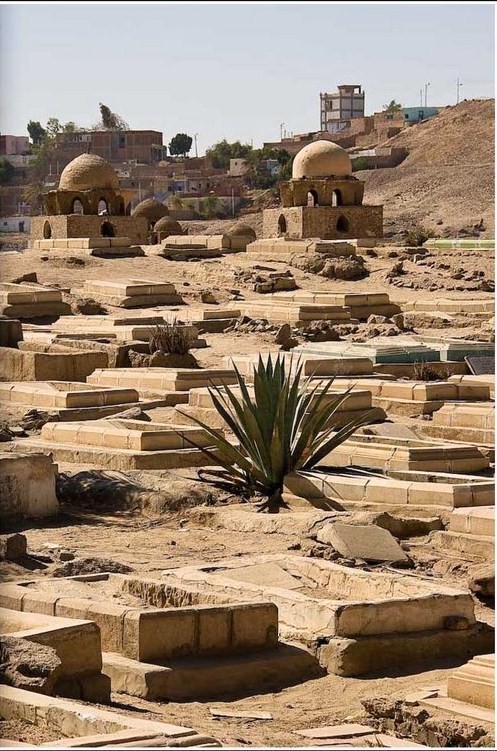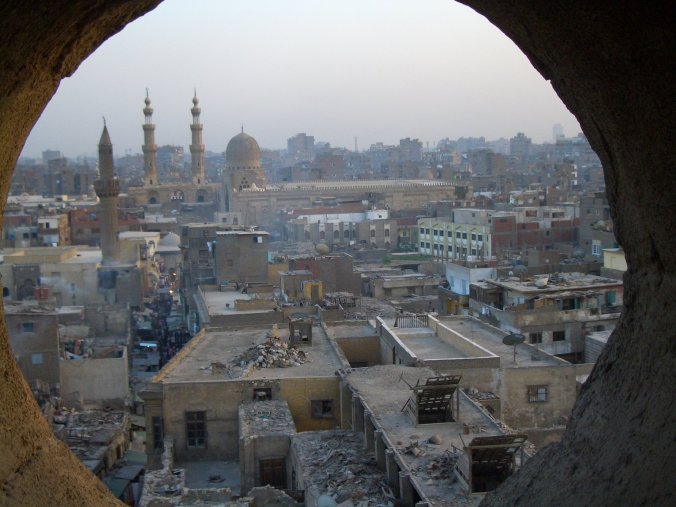Poor Egyptians are embracing the Muslim high class Egyptians’ graveyards.

In a one floor building, consisting of two rooms each is equipped with old semi aching furniture. Each house encloses a mudding ground underneath are buried some of the Egyptian upper class Muslims. In this quiet and un-crowded atmosphere live some poor Egyptian families.
Over the past 30 years, a steady stream of poor and often illiterate migrants has abandoned the poor villages of the Nile Valley in Egypt heading for Cairo and other wealthier and industrialized cities. Unable to afford proper housing, they have made their home wherever they can, including the graveyard.
Low Cost
Despite the morbid locale, many graveyard residents said they enjoy the low rent; ranging from 100 to 200 LE per month. They are assigned by the owners of the graveyard to work as grave guards.
Hesham Farghaly, a 70 years old man laying on a bench, beside him a small outlet where he sells candies as well as caned juices, moved there with his parents on 1948. “The rent is really low here, where could I ever find a similar one?“ said Farghaly.
Farghaly and his family are not the only ones to inhabit the shelters built to house coffins in the road to Salah Salem, Helioplis, Cairo. Most graveyard residents spend their lives there and usually they inherit those houses from their parents.
Christians’ graveyards are not for shelter.
There are no Christians’ graveyards’ residents. The Christians are buried in tombs above the ground. That leaves no space for houses to be built around the graves for living as opposed to the Muslims who are buried under the ground.
There is just one family living for the security for every compound where a large group of dead Christians are put in their tombs. “I’m living here with my whole family since 24 years,” said George Walid. He added that he has a flat outside and he earns his living as working as a guard there.
Dead People are far better than alives.
It is safe to live in inhabited graveyards as opposed to others without residents. Graveyards without residents living there are dangerous, “people commit all types of crimes there,” said Farghali. The place is empty, no one is around which make it so attractive for people who want to rape or murder or steal dead bodies.
“Sometimes dead people are far better than those alive,” said Hakima Abd Elhakim, a 65 year old mother and housewife, who has been living in the graveyards’ area in the road to Salah Salem, Helioplis, Cairo since she got married 50 years ago. No ghosts and nothing scary there because the place is alive with people living there.
They’re like us.
Graveyards’ residents send their children to national schools nearby and mostly by the year they finish high school, they teach them a profession to earn their living from. They train them to be a car mechanic or plumber or the like professions.
When they get married, many search for flats outside the graves area because they as well as their parents think that this would help them live a better life. Others think that their houses would not afford adding families of their children so they help them get flats elsewhere.
They celebrate their weddings at the graveyards area. Pop music, dancing and food catering are their elements of celebration like any other wedding done by poor people elsewhere by the Egyptians.

A person coming sadly to visit a dead relative or a friend is a good event for those people because they mostly give them money. They say that is rarely when people come for a visit, “it happens every year or something,” said Farghaly. It is a religious tradition that when people go to visit a tomb they give away money and food “bakery products” to the poor people living there.
Graveyard residents’ earn their living through working as employees in governmental institutions. They work in jobs as office boys or security men.
Cheap and Profitable.
According to Mohamed Helmy, a police officer in the Saieda Zeinab area, “most of them live here because they earn money from here.” He added that the majority have houses outside the grave area but still live there to gain money because that is what they do for living.
After they retire they seek other jobs to help them feed their families. The money they acquire from charity done at the graveyards area and the monthly pension they earn after retirement; averaging from 300 to 450 LE, are not convenient for a living. “I used to work for the social affairs institution and since my retirement I have been working as a driver,” said Mahmoud Ahmed.
Homes without address.
Some homes at the graveyards area don’t have an address; their residents could neither name the building number of their home nor the street name. “I’ve registered my children on the address of my family on the country side,” said Um Mohamed in her late fifties, explaining what she did to find an address for her newly born children at that time.
Um Mohamed has come with her husband 20 years ago from the country side searching for a better life but “life has ended with us finding nowhere to live but here.” Her house consists of only one room made of canned silver where she lives with her four sons in the Tagamoa Elkhames graveyard area.
Police officers at Saieda Zeinab area do not have extra work to do with the graveyard residents; they think they are “poor” and “calm” people. “Nothing unique about graveyard residents’ crimes reports, neither the kind nor the number of crimes done by them,” said a police officer who has chosen to be anonymous. He thinks that crimes of rape or killing or stealing of dead bodies happen in graveyards with no residents only.
Very nice topic Ekram, it really attracted me. I think you made a great effort to reach such information in such a difficult but amazing and strange topic to tackle. This is brave from you. Go on.